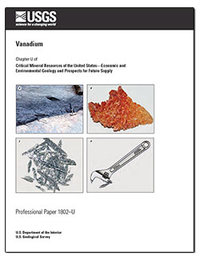Vanadium
Links
- Document: Report (10.2 MB pdf)
- Larger Work: This publication is Chapter U of Critical mineral resources of the United States—Economic and environmental geology and prospects for future supply
- Download citation as: RIS | Dublin Core
Abstract
Vanadium is used primarily in the production of steel alloys; as a catalyst for the chemical industry; in the making of ceramics, glasses, and pigments; and in vanadium redox-flow batteries (VRBs) for large-scale storage of electricity. World vanadium resources in 2012 were estimated to be 63 million metric tons, which include about 14 million metric tons of reserves. The majority of the vanadium produced in 2012 was from China, Russia, and South Africa.
Vanadium is extracted from several different types of mineral deposits and from fossil fuels. These deposits include vanadiferous titanomagnetite (VTM) deposits, sandstone-hosted vanadium (with or without uranium) deposits (SSV deposits), and vanadium-rich black shales. VTM deposits are the principal source of vanadium and consist of magmatic accumulations of ilmenite and magnetite containing 0.2 to 1 weight percent vanadium pentoxide (V2O5). SSV deposits are another important source; these deposits have average ore grades that range from 0.1 to greater than 1 weight percent V2O5. The United States has been and is currently the main producer of vanadium from SSV deposits, particularly those on the Colorado Plateau. Vanadium-rich black shales occur in marine successions that were deposited in epeiric (inland) seas and on continental margins. Concentrations in these shales regularly exceed 0.18 weight percent V2O5 and can be as high as 1.7 weight percent V2O5. Small amounts of vanadium have been produced from the Alum Shale in Sweden and from ferrophosphorus slag generated during the reduction of phosphate to elemental phosphorus in ore from shales of the Phosphoria Formation in Idaho and Wyoming. Because vanadium enrichment occurs in beds that are typically only a few meters thick, most of the vanadiferous black shales are not currently economic, although they may become an important resource in the future. Significant amounts of vanadium are recovered as byproducts of petroleum refining, and processing of coal, tar sands, and oil shales may be important future sources.
Vanadium occurs in one of four oxidation states in nature: +2, +3, +4, and +5. The V3+ ion has an octahedral radius that is almost identical to that of (Fe3+) and (Al3+) and, therefore, it substitutes in ferromagnesian minerals. During weathering, much of the vanadium may partition into newly formed clay minerals, and it either remains in the +3 valence state or oxidizes to the +4 valence state, both of which are relatively insoluble. If erosion is insignificant but chemical leaching is intense, the residual material may be enriched in vanadium, as are some bauxites and laterites. During the weathering of igneous, residual, or sedimentary rocks, some vanadium oxidizes to the +5 valence state, especially in the intensive oxidizing conditions that are characteristic of arid climates.
The average contents of vanadium in the environment are as follows: soils [10 to 500 parts per million (ppm)]; streams and rivers [0.2 to 2.9 parts per billion (ppb)]; and coastal seawater (0.3 to 2.8 ppb). Concentrations of vanadium in soils (548 to 7,160 ppm) collected near vanadium mines in China, the Czech Republic, and South Africa are many times greater than natural concentrations in soils. Additionally, if deposits contain sulfide minerals such as chalcocite, pyrite, and sphalerite, high levels of acidity may be present if sulfide dissolution is not balanced by the presence of acid-neutralizing carbonate minerals. Some of the vanadium-bearing deposit types, particularly some SSV and black-shale deposits, contain appreciable amounts of carbonate minerals, which lowers the acid-generation potential.
Vanadium is a micronutrient with a postulated requirement for humans of less than 10 micrograms per day, which can be met through dietary intake. Primary and secondary drinking water regulations for vanadium are not currently in place in the United States. Vanadium toxicity is thought to result from an intake of more than 10 to 20 milligrams per day. Vanadium is essential for some biological processes and organisms. For example, some nitrogen-fixing bacteria require vanadium for producing enzymes necessary to convert nitrogen from the atmosphere into ammonia, which is a more biologically accessible form of nitrogen.
Suggested Citation
Kelley, K.D., Scott, C.T., Polyak, D.E., and Kimball, B.E., 2017, Vanadium, chap. U of Schulz, K.J., DeYoung, J.H., Jr., Seal, R.R., II, and Bradley, D.C., eds., Critical mineral resources of the United States—Economic and environmental geology and prospects for future supply: U.S. Geological Survey Professional Paper 1802, p. U1–U36, https://doi.org/10.3133/pp1802U.
ISSN: 2330-7102 (online)
ISSN: 1044-9612 (print)
Table of Contents
- Abstract
- Introduction
- Geology
- Resources and Production
- Exploration for New Deposits
- Environmental Considerations
- Problems and Future Research
- Acknowledgments
- References Cited
| Publication type | Report |
|---|---|
| Publication Subtype | USGS Numbered Series |
| Title | Vanadium |
| Series title | Professional Paper |
| Series number | 1802 |
| Chapter | U |
| ISBN | 978-1-4113-3991-0 |
| DOI | 10.3133/pp1802U |
| Publication Date | December 19, 2017 |
| Year Published | 2017 |
| Language | English |
| Publisher | U.S. Geological Survey |
| Publisher location | Reston, VA |
| Contributing office(s) | Central Mineral and Environmental Resources Science Center |
| Description | viii, 36 p. |
| Larger Work Type | Report |
| Larger Work Subtype | USGS Numbered Series |
| Larger Work Title | Critical mineral resources of the United States—Economic and environmental geology and prospects for future supply |
| Online Only (Y/N) | N |
| Additional Online Files (Y/N) | N |


